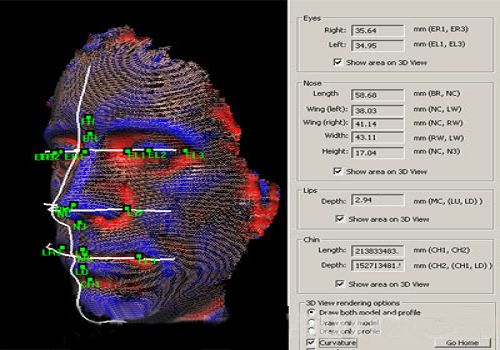 From 3D movies and TVs to 3D fingerprint attendance systems, it seems that the concept of 3D technology has gradually entered our daily lives. Now, this technology is stepping into the field of facial recognition, raising new questions about its future development—will it bring smooth, accurate results, or will it face challenges along the way?
3D Face Recognition in Practice
When it comes to biometric access control, facial recognition offers a more secure and efficient solution compared to traditional methods like fingerprint scanning. While fingerprint systems are widely used for time and attendance, face recognition goes a step further by identifying individuals with higher accuracy and reducing fraud risks. The core idea behind 3D face recognition is based on capturing the unique geometric structure of a person’s face, which can be stored in a database. When comparing this data with a real-time "live" face, if the match is accurate, the system grants access.
One of the key advantages of 3D face recognition is its non-contact nature, making it ideal for applications where hygiene and convenience are important, such as in access control systems. However, despite these benefits, the technology is still in early stages of research and development. Integrating 3D recognition into practical applications remains limited, largely due to the complexity involved in capturing and storing 3D templates, which is more challenging than 2D technologies.
Although 3D systems may not be as cost-effective as some other biometric solutions, they are still considered a promising approach for future development. Industry experts believe that 3D face recognition has the potential to enable one-to-one identification, especially when combined with surveillance systems for forensic purposes. This combination could significantly enhance security and accuracy in critical scenarios.
The Road Ahead for 3D Facial Recognition
In the case of fingerprinting, the integration of 3D technology allows for deeper and more detailed recognition, from the skin surface down to subcutaneous layers. This leads to improved performance and reliability. For facial recognition, the development focuses on capturing a 3D image of a normal face and storing its geometric features in a database. When a real face is scanned, the system performs a full-scale comparison of the 3D data, greatly reducing the chances of false positives.
While 3D recognition might take slightly longer to verify compared to some standard facial recognition systems, the one-to-one matching process enhances overall accuracy and device efficiency. This makes 3D face recognition a more reliable option for independent operations.
In short, the introduction of 3D technology into facial recognition adds a new dimension to the verification process, making it more comprehensive and robust. But the big question remains: in real-world applications, will 3D face recognition work as smoothly as we hope?
From 3D movies and TVs to 3D fingerprint attendance systems, it seems that the concept of 3D technology has gradually entered our daily lives. Now, this technology is stepping into the field of facial recognition, raising new questions about its future development—will it bring smooth, accurate results, or will it face challenges along the way?
3D Face Recognition in Practice
When it comes to biometric access control, facial recognition offers a more secure and efficient solution compared to traditional methods like fingerprint scanning. While fingerprint systems are widely used for time and attendance, face recognition goes a step further by identifying individuals with higher accuracy and reducing fraud risks. The core idea behind 3D face recognition is based on capturing the unique geometric structure of a person’s face, which can be stored in a database. When comparing this data with a real-time "live" face, if the match is accurate, the system grants access.
One of the key advantages of 3D face recognition is its non-contact nature, making it ideal for applications where hygiene and convenience are important, such as in access control systems. However, despite these benefits, the technology is still in early stages of research and development. Integrating 3D recognition into practical applications remains limited, largely due to the complexity involved in capturing and storing 3D templates, which is more challenging than 2D technologies.
Although 3D systems may not be as cost-effective as some other biometric solutions, they are still considered a promising approach for future development. Industry experts believe that 3D face recognition has the potential to enable one-to-one identification, especially when combined with surveillance systems for forensic purposes. This combination could significantly enhance security and accuracy in critical scenarios.
The Road Ahead for 3D Facial Recognition
In the case of fingerprinting, the integration of 3D technology allows for deeper and more detailed recognition, from the skin surface down to subcutaneous layers. This leads to improved performance and reliability. For facial recognition, the development focuses on capturing a 3D image of a normal face and storing its geometric features in a database. When a real face is scanned, the system performs a full-scale comparison of the 3D data, greatly reducing the chances of false positives.
While 3D recognition might take slightly longer to verify compared to some standard facial recognition systems, the one-to-one matching process enhances overall accuracy and device efficiency. This makes 3D face recognition a more reliable option for independent operations.
In short, the introduction of 3D technology into facial recognition adds a new dimension to the verification process, making it more comprehensive and robust. But the big question remains: in real-world applications, will 3D face recognition work as smoothly as we hope?Twist Drill Bit,High Speed Steel Twist Drill Bits,Precision Twist Drill Bits,Easy Twist Drill Bit Tool
Danyang Yongshun Tools Co.,Ltd , https://www.china-drill-bit.com